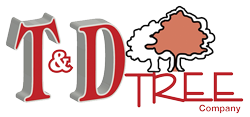Award-Winning Tree Care & Maintenance in Essex County
Trimming evergreen trees and tree pruning is an essential part of keeping your trees healthy and looking their best. Many people feel that tree trimming & pruning is a task they can take on themselves, but without the knowledge and experience of a trained tree service professional, over-pruning can have a negative impact on the natural growth of the tree, causing irreparable damage. Our certified arborists and tree pruning & trimming specialists at T&D Tree Service can provide you with professional maintenance services to stimulate growth, sustain health, and protect your trees from damage.
TREE CUTTING & PRUNING METHODS
CROWN CLEANING
Crown Cleaning a tree involves pruning the deadwood, diseased, and dying limbs out of the canopy of a tree. Crossing and rubbing limbs are also generally pruned also. This type of pruning is extremely beneficial for the health and promotes longevity for a tree.
CROWN THINNING
Crown Thinning a tree involves lightly pruning the interior limbs of a tree canopy. Generally, this is done to achieve more sunlight on a customer’s lawn or to prevent storm damage. Lightly thinning the interior allows for wind flow to better flow through the canopy, thus reducing the chances of limb failure in a storm. Usually, it is recommended to only cut approximately 10-15% of the live growth in the interior and to avoid lion tailing.
CROWN RAISING
Crown Raising a tree involves elevating or cutting the lower limbs of a tree canopy. This type of pruning is usually done to achieve visibility or to allow lawnmowers to be able to mow grass underneath without a tree limb in the way, or anything else such as cars and people to be able to pass underneath trees canopy. Elevating the low limbs on a tree can also allow for structure or clearance pruning as described below.
CROWN REDUCE
Crown Reducing a tree involves lightly thinning out the top of a tree’s canopy. Do not mistake this for tree topping. Topping is NOT a recommended pruning method and should be avoided. A proper crown reduction will reduce the overall crown height and canopy, without altering branch integrity. This type of pruning minimized storm damage and reduces the chances that larger taller trees falling or uprooting in a storm. We often call this type of pruning a light thinning or selective prune in the top of the canopy. Usually, there won’t be a lot of brush or limbs coming out of the tree, but only a selective set of branches the arborist cuts.
CLEARANCE PRUNING
Clearance pruning a tree involves cutting the limbs of a tree away from a structure by a certain # of feet. Proper cuts should be made according to ANSI standards, always cut back to the nearest lateral growth, never cut in the middle of the internode of a branch. Clearance pruning is usually done to clear houses, roofs, sheds, cars, and such of encroaching limbs.
SHAPING
Shaping a tree’s canopy should really only be done on shrubs and bushes – not trees. Larger trees can be shaped but only by a selective prune with proper cuts – not topping. Small shrubs and bushes like Holly trees, bush hedges, and other shrubs and bushes can be shaped how you like them. Some green should always be left or the plant has been shaped too hard and faces the chance of declining. Hand shears are usually used when shaping is completed. Usually, shears are used for this method of pruning on very selective types of trees such as smaller shrub evergreens or privacy hedges.

